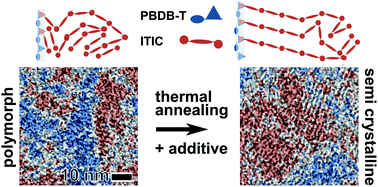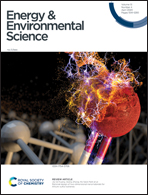Visualizing morphological principles for efficient photocurrent generation in organic non-fullerene acceptor blends†
Abstract
The efficiency of organic solar cells with donor polymers and non-fullerene acceptors depends on a complex morphology. Similar chemical and electronic structures impede generating in-depth insights in morphological details. We visualise molecular arrangements and the nanomorphology in PBDB-T:ITIC blends by correlating transmission electron micrographs and material distribution maps. Material phases are identified by machine learning on hyperspectral data from electron spectroscopic imaging. We observe a specific polymorph of ITIC after thermal annealing. During annealing, enhanced by the presence of additives, PBDB-T acts as nucleation site for ITIC due to strong π–π-interactions of the electron withdrawing groups of both molecules. This leads to efficient charge transport paths in ITIC phases with direct π–π-contact to PBDB-T at the interface. We conclude that π–π-stacking between donor and acceptor molecules facilitates charge carrier generation within mixed interface regions.



 Please wait while we load your content...
Please wait while we load your content...